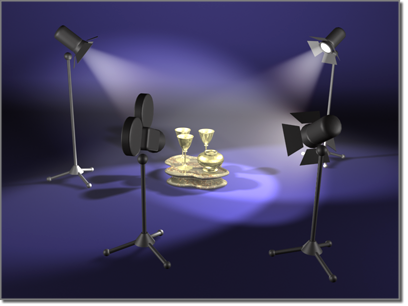You place lights and cameras to complete your scene in much the same way lights and cameras are placed on a movie set prior to filming.

Lights and cameras placed to compose a scene

The resulting scene
Default Lighting
Default lighting evenly illuminates the entire scene. Such lighting is useful while modeling, but it is not especially artistic or realistic.
Placing Lights
You create and place lights from the Lights category of the Create panel or menu when you are ready to get more specific about the lighting in your scene.
3ds Max includes the following standard light types: omni, spot, and directional lights. You can set a light to any color and even animate the color to simulate dimming or color-shifting lights. All of these lights can cast shadows, project maps, and use volumetric effects.
Photometric Lights
Photometric lights provide you with the ability to work more accurately and intuitively using real-world lighting units (lumens and candelas). Photometric lights also support industry-standard photometric file formats (IES, CIBSE, LTLI) so that you can model the characteristics of real-world manufactured luminaires, or even drag ready-to-use luminaires from the Web. Used in conjunction with the 3ds Max radiosity solution, photometric lights let you evaluate more accurately (both physically and quantitatively) the lighting performance of your scene.
Photometric lights are available from the Create panel  Lights drop-down list.
Lights drop-down list.
Daylight System
The Daylight system combines sunlight and skylight to create a unified system that follows the geographically correct angle and movement of the sun over the earth at a given location. You can choose location, date, time, and compass orientation. You can also animate the date and time. This system is suitable for shadow studies of proposed and existing structures.
Viewing Lighting Effects in the Scene
When you place lights in a scene, the default lighting turns off and the scene is illuminated only by the lights you create. The illumination you see in a viewport is just an approximation of the true lighting. Render your scene to view lighting accurately.
Placing Cameras
You create and place cameras from the Cameras category of the Create panel. Cameras define viewpoints for rendering, and you can animate cameras to produce cinematic effects such as dollies and truck shots.
You can also create a camera automatically from a Perspective viewport by using the Create Camera from View command found on the Views menu. Just adjust your Perspective viewport until you like it, and then choose Views  Create Camera From View. 3ds Max creates a camera and replaces the Perspective viewport with a Camera viewport showing the same perspective.
Create Camera From View. 3ds Max creates a camera and replaces the Perspective viewport with a Camera viewport showing the same perspective.